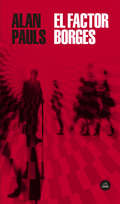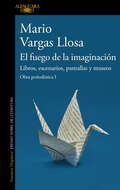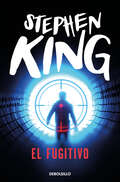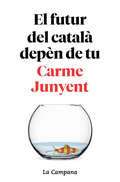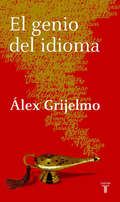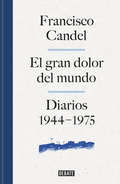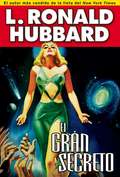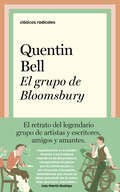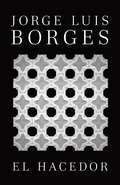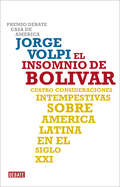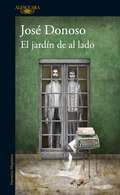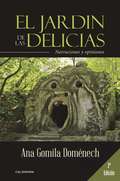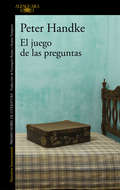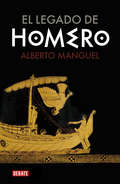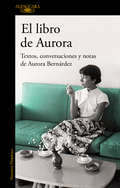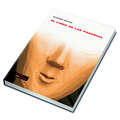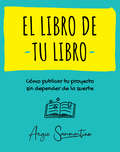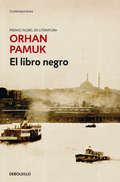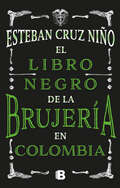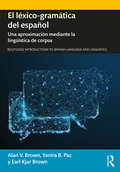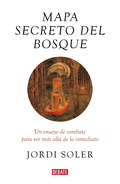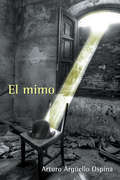- Table View
- List View
El factor Borges: Nueve Ensayos Ilustrados (Tezontle/fondo De Cultura Económica Ser.)
by Alan Pauls¿Cuál es la clave, la contraseña o la molécula inigualable que constituye la esencia de lo borgeano? Alan Pauls hilvana, a su manera, un manual de instrucciones que da cuenta de la obra más importante que dio la literatura argentina. Pero más que un conjunto de ensayos críticos, El factor Borges atraviesa los principales conceptos asociados a ese universo -originalidad, tradición, biblioteca- para mapear no solo el núcleo de sus textos, sino también la configuración de su identidad. Una búsqueda tan profunda como incesante por la imagen que proyectó durante su vida y de manera póstuma y, por supuesto, esa maquinaria perfecta que se anticipó a su tiempo y trasciende su propia sintaxis. También lo que no siempre llegamos a considerar sobre Borges encuentra una dimensión en este libro. Incluso su perseverante naturaleza pendenciera y esas estrategias sutiles pero significativas que Pauls interpreta de manera magistral, como la aparente coquetería de quitarse solo un año de edad para coincidir exactamente con el siglo que le tocó vivir.
El fuego de la imaginación: Obra periodística I
by Mario Vargas LlosaLA CULTURA, PROTAGONISTA DEL PRIMER VOLUMEN DE LA OBRA PERIODÍSTICA DEL PREMIO NOBEL DE LITERATURA MARIO VARGAS LLOSA «No hay cultura genuina sin pluralidad de ideas y sin crítica» Durante más de sesenta años, Mario Vargas Llosa ha desarrollado una intensa labor como articulista. Para él, los textos publicados en medios escritos de todo el mundo son una especie de autobiografía intelectual, literaria y política que ha ido levantando al ritmo de la actualidad de cada momento. Con este volumen dedicado a la cultura, Alfaguara da comienzo a la publicación de la obra periodística del premio Nobel peruano, y lo hace siguiendo una estructura temática, lo que permite al lector descubrir en profundidad el ideario del autor a través del tiempo en cada una de las materias. «Éstas son las reflexiones maduradas a lo largo de una vida dedicada a la lectura de novelas, a la contemplación del arte, del teatro y del cine. No sólo el testimonio entusiasta de intensas horas de placer o de digestiones felices después de haber leído o visto los frutos de la fantasía. También es una aproximación comprensiva a la condición humana, a su mundo subjetivo —sus valores, conflictos, deseos, anhelos y preocupaciones— y a la manera en que han dejado su huella en la historia. No sé si el futuro se pueda leer en la palma de la mano, en los posos de café o en los arcanos del tarot. El presente, en cambio, y de esto no tengo dudas, se puede intuir en el fuego de la imaginación. Y ni siquiera hace falta ser un mago o tener poderes para ello. Basta —y este volumen lo demuestra— con ser un lector y un espectador apasionado y crítico». Del prólogo de Carlos Granés La crítica ha dicho:«La escritura de Mario Vargas Llosa ha dado forma a nuestra imagen de Sudamérica y tiene su propio capítulo en la historia de la literatura contemporánea. En sus primeros años, fue un renovador de la novela, hoy, un poeta épico.»Per Wästberg, presidente del Comité Nobel «Entre nuestros contemporáneos, nadie mejor que el Premio Nobel de 2010 ha sido capaz de seducir amablemente a una gran masa de lectores contándoles historias llenas de sentido con una prosa tan bella como eficaz. Y con un dominio de las estrategias narrativas que la evolución de la literatura del siglo XX instrumentó para superar la manera de hacer novela en el siglo anterior.»Darío Villanueva «Sus libros contienen la más compleja, apasionada y persuasiva visión de la novela y del oficio de novelista de la que tengo noticia; también contienen el mejor estímulo que un novelista puede encontrar para escribir, un estímulo solo inferior al que contienen las propias novelas de Vargas Llosa.»Javier Cercas, El País
El fugitivo
by Stephen KingUna angustiante novela del maestro de terror Stephen King sobre un aterrador futuro donde la televisión es la única realidad. A mediados del siglo XXI, un concurso televisivo, cuyo principal atractivo es la muerte de los participantes, bate récords de audiencia. Ben Richards, padre de una niña enferma y sumido en la más profunda miseria, decide concursar atraído por los extraordinarios premios, aun a sabiendas de que no sobrevivirá. Sometido a una implacable persecución, se plantea un único objetivo: resistir tantos días como sea posible para aumentar el premio y asegurar la subsistencia de su familia.
El futur del català depèn de tu
by Carme Junyent Bel ZaballaUna proposta per evitar que la llengua catalana desaparegui. El següent diàleg segurament us és familiar: -Què et costa parlar en castellà? -Ben mirat, no em costa gens. Tinc la sort de saber-ne; per tant, no compliquem les coses. Carme Junyent és especialista en l'estudi de llengües amenaçades arreu del món. Coneix profundament els tics, les autotrampes i, en definitiva, els símptomes d'un camí sense retorn. Per això ens alerta i ens explica de manera clara i diàfana el com i el per què el català està malalt. Sí, el català corre perill. Però encara no és massa tard! Per salvar la llengua TOTS hem de canviar urgentment el nostre comportament lingüístic. Els que la tenim com a primera llengua. I els que no, però que la volem continuar sentint, o també parlant. -Què em costa parlar en castellà? -Em costa que cada vegada que NO parlo en català, porto la llengua cap a un camí de no-retorn. I per això necessito aprendre a no cedir sempre. I també per això cal que tu et posis en el meu lloc, perquè tots plegats entenguem què hi ha en joc. Sense tu i sense mi no ens en sortirem pas. Perquè el català té un avantatge únic: hi ha moltíssima gent que no el parla però l'entén. I fins i tot molts l'estimen. Aprofitem-ho!
El genio del idioma
by Álex Grijelmo¿Qué es lo que nos hace identificar palabras como propias o ajenas, o asignarlas a una u otra lengua?: el genio de cada idioma, que alcanzamos a identificar someramente incluso aunque no lo conozcamos. <P><P>Si usted lee der schwankende Wacholder flüstert, sabrá que está ante una frase en alemán. Y pensará que se ha topado con el inglés si ve en un texto before it is too late. Y no dudará que se escribió en italiano la frase e'un ragazzo molto robusto che non presenta particolari problema. <P>Si escucha la palabra cusa en un contexto español, pensará que es un vocablo que usted desconoce pero que probablemente existe (porque sí están en nuestro idioma "casa", "cesa", o "cosa", o "musa", o "rusa", "lusa", o "fusa"). <P>Aunque en realidad no exista. Pero a usted le sonará español si las palabras que la rodean son castellanas. Y, si es usted español, no le cabrá ninguna duda de qué lengua tiene ante sus ojos si lee txamangarria zera eder eta zeranere biotzak ez du zu besteroik maite. <P>En efecto, es euskera. ¿Qué es lo que nos hace identificar palabras como propias o ajenas, o asignarlas a una u otra lengua?: el genio de cada idioma, que alcanzamos a identificar someramente incluso aunque no lo conozcamos. Esta obra se pregunta -y procura algunas respuestas- sobre el genio del idioma español. <P>Qué le gusta y qué rechaza, cómo se comporta desde hace siglos y cuáles son sus manías y sus misterios. Sabiendo todo eso, adivinaremos mejor cómo somos nosotros y cómo va a evolucionar nuestra lengua.
El gran dolor del mundo: Diarios (1944-1975)
by Francisco CandelEl gran dolor del mundo reúne una amplia selección de los diarios inéditos de Francisco Candel, quien llevó constancia de su día a día desde 1944 hasta pocas semanas antes de morir, en 2007. En la cubierta del primer volumen de sus diarios, Francisco Candel escribió: «Quien quiera que seas, si por casualidad tropiezas con este cuaderno, no cometas la indiscreción de leerlo». Sin embargo, con el tiempo cobró conciencia de su interés como testimonio incalculable de una época y de sí mismo. Candel fue un hombre de frontera, entre el precario mundo que le vio nacer, al que sería fiel en su obra toda la vida, y el mundo letrado catalán, al que se incorporaría contando solo con su intensa vocación por la literatura. Este volumen se cierra con la muerte de Franco, un hecho que se convertiría en una obsesión para él, pues significaba el fin del autoritarismo político. A lo largo de su obra, Candel recorrió ampliamente su propia biografía, pero los diarios, escritos con una minuciosidad conmovedora, ponen de manifiesto la coherencia entre vida y obra; la creencia en la responsabilidad universal a la manera en que la sintieron los escritores rusos: cada uno de nosotros es responsable ante los demás por todo lo que ocurre. Tal pensamiento le condujo a una estética de un realismo radical, donde solo tenía cabida la verdad de lo observado por él. Los diarios recogen la épica cotidiana de la gente que sufre, a la que acecha la miseria y a la que Candel dota de una particular elevación moral. El gran dolor del mundo también da cuenta de sus preocupaciones, de su lucha por ser un escritor, más allá de la precariedad de sus orígenes, sus problemas con la censura, sus angustias metafísicas, la vida cotidiana bajo el franquismo o la difícil felicidad conyugal.
El gran dolor del mundo: Diarios (1944-1975)
by Francisco CandelEl gran dolor del mundo reúne una amplia selección de los diarios inéditos de Francisco Candel, quien llevó constancia de su día a día desde 1944 hasta pocas semanas antes de morir, en 2007. En la cubierta del primer volumen de sus diarios, Francisco Candel escribió: «Quien quiera que seas, si por casualidad tropiezas con este cuaderno, no cometas la indiscreción de leerlo». Sin embargo, con el tiempo cobró conciencia de su interés como testimonio incalculable de una época y de sí mismo. Candel fue un hombre de frontera, entre el precario mundo que le vio nacer, al que sería fiel en su obra toda la vida, y el mundo letrado catalán, al que se incorporaría contando solo con su intensa vocación por la literatura. Este volumen se cierra con la muerte de Franco, un hecho que se convertiría en una obsesión para él, pues significaba el fin del autoritarismo político. A lo largo de su obra, Candel recorrió ampliamente su propia biografía, pero los diarios, escritos con una minuciosidad conmovedora, ponen de manifiesto la coherencia entre vida y obra; la creencia en la responsabilidad universal a la manera en que la sintieron los escritores rusos: cada uno de nosotros es responsable ante los demás por todo lo que ocurre. Tal pensamiento le condujo a una estética de un realismo radical, donde solo tenía cabida la verdad de lo observado por él. Los diarios recogen la épica cotidiana de la gente que sufre, a la que acechala miseria y a la que Candel dota de una particular elevación moral. El gran dolor del mundo también da cuenta de sus preocupaciones, de su lucha por ser un escritor, más allá de la precariedad de sus orígenes, sus problemas con la censura, sus angustias metafísicas, la vida cotidiana bajo el franquismo o la difícil felicidad conyugal.
El gran secreto
by L. Ronald HubbardFanner Marston est a punto de descubrir la clave para conseguir el control absoluto del universo. El nico problema es que est loco de atar: un enloquecido Anthony Quinn con muchos humos. Impulsado por la avaricia y el ansia de poder, lo nico que le preocupa es llegar a la antigua ciudad de Parva y encontrar el gran secreto del poder absoluto. Pero est escrito en los muros de Parva. . . y no creern lo que dice.
El grupo de Bloomsbury
by Quentin BellLa historia del legendario grupo de artistas y escritores, amigos y amantes, y su influencia en la sociedad inglesa de principios del siglo XX y en las siguientes generaciones. Virginia Woolf, Roger Fry, J. M. Keynes, Lytton Strachey, Harold Nicolson, Vita Sackville, Duncan Grant... El grupo de Bloomsbury fue un exclusivo círculo de talentos sobresalientes, de intelectuales vanguardistas que destacaron en disciplinas como la literatura, el arte, la economía y la filosofía. Junto con otras figuras de la aristocracia y la intelectualidad londinense, como T. S. Eliot, Bertrand Russell o E. M. Forster, desafiaron la moral victoriana y constituyeron un fascinante clan que Quentin Bell, desde su privilegiada posición familiar, observa en este maravilloso libro. Quentin Bell (1910-1996) fue un crítico, historiador del arte y escritor inglés, hijo de Vanessa y Clive Bell, dos pilares del grupo de Bloomsbury, y autor, entre otros, de la aclamada biografía de su tía, Virginia Woolf.
El hacedor: Poesia (El\libro De Bolsillo Ser. #Vol. 9)
by Jorge Luis BorgesYo vivo, yo me dejo vivir, para que Borge pueda tramar su literatura y esa literatura me justifica. De Borges y yo Considerado por el mismo Borges como su libro más personal, El hacedor explora la relación entre el mundo interior y exterior del artista, el misterioso espacio entre sus sueños y la vida real. Un maravilloso cruce de géneros y temáticas, los relatos, ensayos y poemas de esta colección reflejan muchas de las preocupaciones centrales que recorren toda la obra borgiana. En fascinantes escritos como Diálogo sobre un diálogo, La trama, Dreamtigers, y Borges y yo, entre otros muchos, Borges examina la serenidad de la mente creativa, el espectáculo de su figura pública, y mira hacia el más allá: el mundo eterno en el que sus libros continuarán dialogando con la literatura universal mucho después de que él mismo haya desaparecido. Valorado por la crítica como una de las obras más importantes del siglo xx, El hacedor es un extraordinario ejemplo del poder del maestro argentino, el alcance de su visión creativa y su inagotable contribución a la literatura.
El hombre de la cámara mágica
by Pedro José BadranUna novela de Pedro Badrán. Con su cámara de instantáneas, Tony Lafont se proponehacer un inventario exhaustivo de un hotel de Cartagena. Tiene lamisteriosa convicción de que cada uno de los objetos que lo pueblan, sushabitaciones, las sombras bamboleantes sobre sus paredessalitrosas, así como sus huéspedes, presentes y pasados,son el reflejo del universo. La novela es la historia de ambos, delhotel y del fotógrafo, de la leyenda que gestaron, pero es sobre todo unálbum fascinante de una época y unos personajes llenos de contrastes,lúcidos, ingenuos, tiernos, melancólicos, divertidos.«En esta novela, el asunto no es únicamente el rastreode un fotógrafo legendario y sus huellas en un hospedaje caribeño, sinoel registro de unas vidas que pasan lentamente, sin fecha devencimiento, a la espera de la hora de entregar la última habitación."Como siempre, es notable la prosa de Pedro Badrán, su grancapacidad para crear atmósferas».Juan Manuel Roca«Nadie como Pedro Badrán para captar el alma de sus personajes, pararecrear la sensualidad, la luz y la sonoridad del Caribe con un lenguajesencillo y preciso que nunca aburre al lector».Peter Shultze-Kraft«Badrán es dueño de un estilo en el que la precisión de lenguaje y ellirismo casi sensualista armonizan a la perfección».Diario El País, de España«Nunca he leído un cuento de Pedro Badrán sin una intensa sensación degratitud. La inteligencia, el humor desaforado, el oído impecablepara las formas de hablar de la gente: ahí está todo. Su obra enriquecela tradición de un género que en Colombia no carece deriqueza».Juan Gabriel Vásquez«Poderoso relato sobre la intimidad, los ritos de paso y eldesconcierto, parte de una metáfora aún mayor, puesto que tras las vidasprivadas podemos leer el derrumbe de un país yde una época».Diario Hoy, de España, sobre El día de la mudanza«Estamos en la tradición de la escuela policíaca norteamericana,retomada con acierto por muchos autores latinoamericanos. Nohay duda: la originalidad más interesante es la que vuelve a losorígenes».Revista Semana, sobre Un cadáver en la mesa es mala
El hombre de tu vida
by Juan José Campanella Marcela GuertySe trata de la novelización de la comedia televisiva del mismo nombre,escrita y dirigida por Juan José Campanella y protagonizada porGuillermo Francella, Luis Brandoni y Mercedes Morán que emitió Telefé en2011/2012 y que emitirá HBO para toda Latinoamérica en 2013. Hugo, honesto, trabajador y viudo, cría solo a su único hijo.Desocupado, su prima Gloria le hace una oferta laboral disparatada queno puede rechazar. La necesidad, dicen, tiene cara de hereje. Así setransforma en el candidato comodín de una agencia de citas. Para cadaclienta, Hugo intenta ser el hombre ideal. Lo importante es que cada unaquede tan conforme como para pagar la cuenta y tan desencantada comopara no seguir la relación. Sin poder evitarlo, Hugo se involucraráintensamente con los conflictos emocionales de las mujeres a las queconoce.El hombre de tu vida, éxito de Telefe surgido de la imaginación de JuanJosé Campanella y Marcela Guerty, nos muestra cómo un hombre común ycorriente le quita el velo al universo femenino mientras vareconstruyendo su propia vida.
El insomnio de Bolívar: Cuatro consideraciones intempestivas sobre América Latina en el siglo XXI
by Jorge VolpiUna inteligente reflexión sobre el presente y el futuro de América Latina, ganadora del II Premio Debate-Casa de América. «Fue en España, para ser más preciso en Salamanca, apabullado por las centenarias piedras de Villamayor, frente a las severas estatuas de fray Luis de León y Unamuno, o al menos ante sus nombres inscritos en camisetas, afiches y llaveros, donde descubrí que yo era latinoamericano. Acababa de cumplir veintiocho años y hasta entonces había vivido en México, donde jamás fui consciente de esta condición y donde nunca tuve la fortuna o la desgracia de toparme con alguien que se proclamase miembro de esta especie.» Así arranca Jorge Volpi este deslumbrante recorrido por la América Latina del bicentenario, con sus luces, sus sombras, sus caudillos, sus ex guerrilleros, sus escritores, sus injusticias y sus promesas de un futuro mejor. Las cuatro brillantes consideraciones en que divide el ensayo le sirven para repasar el presente latinoamericana, apuntar sus raíces y atisbar posibles desarrollos en la política, la sociedad y la literatura de la región. En palabras del jurado que le concedió el II premio Debate - Casa de América, Jorge Volpi «recorre, de manera inteligente y seductora, la historia de América Latina desde su pasado mítico hasta su futuro imaginado, escapando al tono académico y contribuyendo, con humor, ironía y gran oficio literario, a la comprensión del continente americano.»
El jardín de al lado
by José DonosoUno de los clásicos e imprescindibles del narrador chileno más importante del siglo XX. Publicada por primera vez cuando José Donoso iniciaba su regreso definitivo a Chile, El jardín de al lado es una novela sobre el fracaso, pero también, de algún modo, sobre la salvación. Julio Méndez, un novelista chileno ya en la cincuentena, exiliado en España y obsesionado por un éxito definitivo que no llega, se debate entre su ansiedad y sus intuiciones sobre la propia e inevitablemediocridad, atormentado por las figuras enigmáticas de Núria Monclús, la todopoderosa agente literaria, y de la estrella máxima del boom, Marcelo Chiriboga. Desgarrada y tragicómica, cotidiana y patética, El jardín de la lado explora los laberintos de la marginalidad interior, más allá de los destierros obligados o voluntarios, de las miserias físicas o de las ambigüedades del deseo. Para dar sentido final a esta «temporada en el infierno», Donoso deberá poner en juego sus habituales mecanismos de ilusión óptica, donde las cosas no son lo que parecen y, al mismo tiempo, lo son irremediablemente.
El jardín de las delicias: Narraciones y opiniones
by Ana Gomila DomènechSi alguna vez os habéis sentido tan marcianos como yo misma por vuestros gustos y aficiones, ¡este libro es para vosotros, pedantes sin remisión! El jardín de las delicias es un delicioso jardín de narraciones y artículos periodísticos con la curiosidad intelectual y el amor por la cultura como abono común. Leer no está bien visto en nuestro país, es como formar parte de una secta. Leer es de frikis canijos y granujientos con gafas de culo de vaso. La gente que mola no tiene tiempo para leer... Si alguna vez os habéis sentido tan marcianos como yo misma por vuestros gustos y aficiones, ¡este libro es para vosotros, pedantes sin remisión!
El juego de las preguntas (Alfaguara Literatura Ser.)
by Peter HandkeNo hay libro de Handke que no constituya un acontecimiento. Obra del Premio Nobel de Literatura 2019. «No es para que nos contesten a una pregunta por lo que nos hemos puesto en camino, sino para que, en el silencio del lugar de los antiguos oráculos, cada uno descubra cuál es su pregunta». Con este designio, siete singulares peregrinos emprenden un iniciático «viaje al país sonoro», una búsqueda espiritual que, bajo distintas formas en diferentes culturas, ha constituido siempre el símbolo supremo de la vida humana. En El juego de las preguntas, Handke propone que nos abramos al mundo por medio de una pregunta esencial, donde se incluyan todas las respuestas. Es el modo de indagación personal que caracteriza toda su obra: averiguar cómo se relaciona el hombre, a partir de sí mismo, con todo su entorno. Cada mirada congela el mundo, lo fragmenta, lo analiza, lo devuelve en palabras (trocadas en eficaces herramientas). Una escritura cuya originalidad llega a las raíces del idioma.
El legado de Homero
by Alberto ManguelAlberto Manguel, Premio Formentor de las Letras 2017, disecciona la Ilíada y la Odisea de Homero para demostrarnos cuán importantes han sido en la construcción de la cultura occidental. A pesar de contar con varias biografías y que unas cuantas ciudades se disputen su nacimiento, no hay vestigios que puedan acreditar con seguridad la existencia de un hombre llamado Homero. Y sin embargo, no hay duda de que las obras reunidas bajo su autoría constituyen la piedra angular sobre la que descansa la literatura occidental. La Ilíada y la Odisea, con sus dioses fieramente humanos, constituyen la narración de las dos grandes metáforas que nos definen a través de los siglos: la vida como lucha y la vida como viaje. Sin importar si estos textos son alegóricos o si pretenden ser testimonio histórico de una época extinta, el rapto de Helena, el caballo de Troya, la cólera de Aquiles, el cíclope, Ulises y Penélope... han alimentado nuestra imaginación durante más de dos mil quinientos años, sirviendo de inspiración a autores posteriores de todas las épocas y geografías: Platón, Virgilio, al-Farabi, San Agustín, Avicena, Dante o Joyce, entre muchos otros. Con erudición prodigiosa, Manguel persigue el legado de Homero a través de las cimas literarias de todos los tiempos, ofreciéndonos este maravilloso libro con el que nos muestra que las pasiones que laten en ambos poemas son sentimientos comunes a toda la humanidad.
El libro de Aurora: Textos, conversaciones y notas de Aurora Bernárdez
by Aurora BernárdezUna privilegiada vía de acceso a los, hasta ahora, desconocidos y múltiples textos literarios de Aurora Bernárdez. «Creo que siempre tuve una vocación de oscuridad y de secreto.» Con esa frase anotada, hacia el final de su vida, en un cuaderno resumió Aurora Bernárdez su vínculo tan particular con la literatura. Por seguir esa vocación nunca traicionada restringió su actuación pública a lo estrictamente necesario y mantuvo para sí misma el ejercicio de su propia creación. El libro de Aurora reúne poemas, relatos y notas de quien fue una traductora brillante, la primera lectora de la obra de Julio Cortázar y su albacea literaria, y contiene además la transcripción de la única y extensa entrevista que concedió. En estos textos que ven la luz por primera vez quedan plasmados su inteligencia, su delicadeza, su talento y su humor, configurando el retrato de una mujer del siglo XX, una mujer de letras a quien el amor llevó a París y cuya amistad con sus editores nos la devuelve hoy en este libro encantador.
El libro de las parodias
by Rado MolinaThis book is a journey through other books, marked by the enjoyment the author gained from deciding what may happen in the next sentence and what made the characters unique. The author, tired of other books, craved irony to maintain his sanity. He admits that this book may in fact be a parody of itself.
El libro de tu libro: Cómo publicar tu proyecto sin depender de la suerte
by Angie SammartinoToda la información para convertir el proyecto de publicación de un libro en una realidad. ¿Tenés el sueño de publicar tu propio libro? ¿Sabías que está al alcance de cualquier persona que se lo proponga? En este libro se revelan los secretos que todo autor necesita saber para transformar su sueño en una realidad. Vas a conocer cómo funciona el mundo editorial, las áreas que intervienen en el proceso de publicación y las razones por las cuales concretarla siguen siendo tan relevantes para escritores y profesionales de todos los rubros. En cada capítulo hay material teórico acompañado por actividades prácticas, para que al leerlo puedas ir dándole forma a tu propio proyecto. Vas a encontrar respuestas concretas sobre cómo trabajar con editoriales grandes, qué es la autopublicación, qué caminos siguieron otros autores, qué trámites tener en cuenta y cómo financiar el proyecto. En estas páginas está toda la información, las herramientas y los consejos necesarios para tomar decisiones que te lleven a publicar con éxito.
El libro negro
by Orhan Pamuk«Un día la hermosa mujer de un hombre que la quería muchísimo lo abandonó. Él empezó a buscarla. Allá donde fuera por la ciudad encontraba su rastro pero no a ella...»Así cuenta su caso Galip, un joven abogado que vive en Estambul y quiere reencontrarse con Rüya, su esposa y prima. Sospecha que ha huido con otro hombre, con un hombre que bien podría ser alguien muy cercano, casi tan cercano como su propio hermanastro, Celâ, un periodista excéntrico que también ha desaparecido. En su persecución alucinada, Galip recorre día y noche las calles de un Estambul real y fabuloso que alberga en cada esquina una historia secreta, y donde todas las pistas, como si fueran cajas chinas, esconden nuevos misterios. Pero cuando Galip da su paso más audaz y asume la identidad de Celâ, ignora el riesgo al que se expone. Porque hay juegos que desembocan en crímenes inesperados.El libro negro es una novela policíaca, tan espectacular como poco convencional, donde la investigación se centra en la identidad y la escritura. Con esta obra, que en Turquía se convirtió a la vez en lectura de culto y de masas, Orhan Pamuk se consagró como uno de los maestros actuales de la literatura mundial.«El libro negro me entusiasmó... Cuando terminé de leerlo hice lo que debía hacer: volver a la primera página y comenzar a releerlo.»Juan Goytisolo
El libro negro de la brujería en Colombia
by Esteban Cruz NiñoIncluye historias sobre la brujería en el Palacio de Nariño durante la presidencia de Ernesto Samper, las maldiciones que rodean al castillo Marroquín y los oscuros rituales que se celebran en la tumba de Pablo Escobar, entre otras. Colombia es una nación en la que la magia parece fundirse con la realidad; un país en donde el realismo mágico surge en cada rincón, y en el que la brujería y los encantamientos se mantienen vigentes a través del tiempo y el espacio. En este nuevo libro, Esteban Cruz Niño reúne diez casos relacionados con estos temas en Colombia, en donde mezcla una rigurosa investigación periodística -de fuentes actuales e históricas- con entrevistas a personajes famosos y de la cultura popular del país para demostrar cómo la brujería, desde siempre, ha permeado todas las esferas de la sociedad.
El léxico-gramática del español: Una aproximación mediante la lingüística de corpus
by Alan V. Brown Yanira B. Paz Earl Kjar BrownEl léxico-gramática del español ofrece una aproximación alternativa al estudio de la gramática avanzada del español. Este libro brinda al estudiante un enfoque auténtico y contextualizado del uso del español, basándose en datos provenientes de corpus de español-L1 y L2 junto a la investigación lingüística a fin de describir las características léxico-gramaticales fundamentales de la lengua y su variación. Cada capítulo incluye actividades guiadas para que los estudiantes puedan realizar búsquedas en estos corpus con el propósito de llegar a conclusiones fundamentadas en evidencias empíricas sobre cómo los aprendices de varios niveles de competencia usan ciertos elementos léxico-gramaticales. Este libro representa un recurso ideal para los estudiantes de la gramática avanzada del español a nivel de pregrado y posgrado. El léxico-gramática del español provides an alternative approach to the study of advanced Spanish grammar. Drawing on L1 and L2 Spanish language corpora and linguistic research to describe key lexico-grammatical characteristics of the Spanish language, this book gives students insight into real, variable, and contextualized usage of Spanish. Each chapter includes guided exercises so that students can conduct their own searches of the corpus and draw evidence-based conclusions on how particular grammar structures are used by Spanish speakers at varying levels of proficiency. This is an ideal resource for advanced undergraduate and postgraduate students of Spanish language and linguistics.
El mapa secreto del bosque
by Jordi SolerUna cautivadora meditación que invita a afrontar los desafíos del siglo XXI viajando por fuera de los caminos trillados. El mapa secreto sirve para encontrar la otra realidad del bosque y de las criaturas que lo habitan, como lo han hecho durante siglos sabios orientales, filósofos, poetas y novelistas, doctores mesméricos, artistas plásticos y brujos mexicanos. El entramado que articula los árboles del bosque tiene su metáfora en la red, la otra realidad existe también en las calles de las ciudades y para vislumbrarla solo hace falta observar con atención, contemplar «la otredad en el mundo de todos los días», como sugería Octavio Paz, basándose en ese principio fundamental del surrealismo que era buscar lo merveilleux quotidien. A partir de sus andaduras por bosques y ciudades, y de una larga lista de lecturas que incluye a Edgar Allan Poe, Demócrito de Abdera, Ernst Jünger, Carlos Castaneda, Salvador Pániker,André Breton, Henri Bergson, Walt Whitman, Emil Cioran, Parménides y C. G. Jung entre otros; Jordi Soler propone una reflexión, un mapa, sobre esa zona de la realidad que el siglo xxi empieza a difuminar. Para contrarrestar la inercia del progreso apela al regreso como forma de integración a los ciclos del cosmos, explora el gran silencio, propone acallar la palabrería interior para poder observar el entorno sin prejuicios -como recomendaba el brujo don Juan Matus-, a fuerza de concentrarse mientras se camina en la intemperie o se juega un set de tenis. Mapa secreto del bosque es la aventura de un novelista que se echa a caminar con su perro para buscar la otredad en el mundo de todos los días, aprovechando el instrumental que está al alcance de cualquiera, el desplazamiento, la poesía, la música, el abrazo, la emboscadura en suma, refugiarse en el bosque para regresar, brevemente y de manera cotidiana, a esa criatura cósmica que, a pesar de la revolución tecnológica que ha transformado nuestras costumbres, no hemos dejado de ser.
El mimo
by Arturo Argüello«La Plaza Bolívar de Bogotá es el escenario donde dos almas separadas y atormentadas, aunque unidas por un intenso amor, sobreviven el día a día de los artistas callejeros de la capital colombiana.» <P><P>Con nostalgias del cálido y mágico Caribe, con sus diferentes pasados y recuerdos felices e infelices, un mimo mulato y analfabeto y una poetisa, junto a un titiritero, un payaso, un fotógrafo, un bailarín y otros eternos buscadores de aplausos y monedas, transmiten desde su música, actuación, baile y poesía su propia visión de las miserias, vicios, pasiones y alegrías de la vida cotidiana. <P> El reencuentro y la unión sólo serán posibles si lo permiten estas intensas y a veces incontrolables pasiones.
